PCI Express & CrossFire: Scaling Explored
Every Generation Of Core 2 Chipset?
Intel 975X
The 975X chipset was ahead of its time, simply because this high-end Core 2 platform burst onto the scene long before the CPU micro-architecture it was designed to complement. Last-minute changes to the Core 2’s specifications caused most early 975X boards to support only previous-generation NetBurst-class processors, and many updated Core 2-compatible models required further modification to support Core 2 Quads. A few manufacturers even delayed the release of 975X-based parts for up to eight months while the new processor architecture was sorted out. With all of the compatibility challenges that faced high-end 975X platform selection, most builders instead selected newer, lesser-featured P965 Express alternatives.

The big advantage Intel’s 975X had over the later P965 was its ability to support two graphics cards from the sixteen PCI Express 1.1 pathways connected directly to the northbridge. This meant that motherboards could support either a single card with full x16 transfers or two cards with x8 transfers. Mainstream chipsets were severely limited in how much bandwidth they could provide a second graphics card, so the 975X became a clear choice for CrossFire and early SLI testing (Nvidia later removed the SLI checkbox from its graphics driver whenever a non-SLI-branded chipset was used).
Asus was on the cutting edge of the change from NetBurst to Core 2-compatible platforms and its P5W DH Deluxe is one of the few 975X-based motherboards that has maintained compatibility with even the latest Core 2 products via simple BIOS updates.
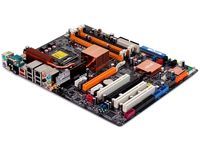
We used P5W DH Deluxe BIOS version 2801 to achieve compatibility with the latest E0 stepping Wolfdale-based Core 2 processors. Though FSB-1333 is officially unsupported by the 975X, Asus added automatic overclocking to its BIOS to assure the processor would function normally, even though the chipset is overclocked.
P965 Express
The formerly-mainstream P965 Express was introduced around the same time as Core 2 Duos reached the market, with better overclocking capability and higher stable memory speeds, putting these motherboards at the top of the list for many enthusiasts. The biggest problem for high-end gaming systems is that this chipset was not designed to support CrossFire technology natively, as this was Intel’s way of differentiating the earlier 975X as its high-end solution.

With all sixteen PCI Express pathways locked together to support only a single graphics card, many motherboard manufacturers decided to use four PCI Express pathways from the new ICH8 series southbridge to supply a second x16 graphics card slot with x4 transfer mode. Though this type of bandwidth reduction is almost unthinkable now, those four pathways were enough to provide good performance to most mainstream graphics cards of the day.
The P5B Deluxe WiFi-AP Edition was one of the most popular P965 motherboards, which is why we reserved this one from our Core 2 motherboard shootout in preparation for today’s article.
Stay On the Cutting Edge: Get the Tom's Hardware Newsletter
Get Tom's Hardware's best news and in-depth reviews, straight to your inbox.
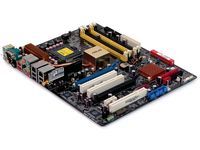
Publicly-available BIOS 1236 wasn’t able to utilize 4 GB of memory and E0 stepping processors simultaneously, so Asus supplied us with a patched BIOS version 1238. Owners should feel free to contact Asus support if the BIOS they need isn’t publicly available yet.
P35 Express
Intel began preparing the world for its late-2008 release of Core i7 with the mid-2007 release of its P35 Express chipset. The P35 Express brought with it support for FSB-1333 processors and DDR3 SDRAM, though Intel left support of DDR2 memory intact.

What made the P35 Express special? Not much. Some users claimed it could overclock better than the P965, but that wasn’t necessarily true when comparing CPU speeds using later-model high-end P965 motherboards. The biggest boon to overclockers was that the DDR3 memory supported by some P35-based models allowed the bus speed to be increased beyond the 600 MHz of DDR2-1200.
With no practical performance advantages for using DDR3 with Core 2 Duo processors, we stuck to DDR2 for all our motherboards and chose the Asus P5K Deluxe WiFi-AP Edition to represent the P35 Express. Choosing a single motherboard brand should help to maintain consistent results when comparing different generations of chipset technology.
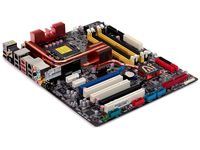
P5K Deluxe BIOS 0902 is the most recent available from Asus, yet it supported our E0 stepping Wolfdale core in spite of its June 19 release date.
X48 Express
Anyone who asks “why did you skip X38?” probably hasn’t read our X48 Express motherboard reviews, because the only difference between the two chipsets is that Intel approved X48 for 1,600 MHz FSB speeds. In fact, both the X48 and X38 have built-in support for FSB1600, also known as the 400MHz boot strap, since the X48 is, at best, a later stepping of the X38. Intel simply delayed the release of 1,600 MHz FSB-capable chipsets until it could validate enough X38 samples at the higher speed, slapping the X48 label on the best parts. On the other hand, a cynical observer could look at the difference between X48 and X38 chipset pricing and draw other conclusions about Intel’s intent.

The two big features Intel released in its X38 were both aimed at high-end graphics. First and foremost was proper support for AMD’s CrossFire technology, which had languished since the 975X. This was accomplished not by splitting sixteen lanes across two slots, but instead by adding sixteen more lanes for full x16 transfer mode to both cards.
In addition to the added pathways, PCI Express 2.0 transfer rates increased peak slot bandwidth by a factor of two. This resulted in the X38/X48 northbridge having four times the peak graphics data throughput of its 975X predecessor.
Because the X38 and X48 chipsets are functionally identical, we could have used either an X38 or X48 motherboard. Asus supplied us with its DDR2-supporting, X48-based P5E Deluxe.
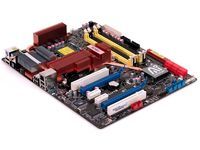
Anyone who still believes that the X48 doesn’t support DDR2 while the X38 does has been hitting the Intel juice a little too hard, because—as we’ve said over and over again—they’re the same chipset design. Though Intel doesn’t want to promote the DDR2 capability of its X48 Express chipsets, X48-based DDR2 motherboards are also available from ASRock, DFI, Gigabyte, and MSI.
We used P5E Deluxe BIOS version 0205 (06/20/2008) to assure compatibility with our E0 stepping Woldale processor.
P45 Express
Is the P45 Express Intel’s last performance chipset? If we use the traditional description of what comprises a chipset, then probably. The memory controller of Core i7 platforms has been moved to the processor and future development of previous-generation designs will probably be limited to low cost, low power, or integrated-graphics markets.

The P45 northbridge brings back the one thing that made the 975X great—the ability to split its sixteen PCI Express lanes among two graphics cards. Bandwidth-doubling PCI Express 2.0 transfer mode gets the P45 in line with modern graphics needs, while the use of “only” sixteen pathways assures that motherboards can be more easily designed and manufactured. By combining lower manufacturing costs and relatively high bandwidth, the P45 became the first Intel chipset to realize the true potential of CrossFire as a mainstream/performance technology, rather than treating it as a high-end-only option.
We reserved the P5Q-Deluxe from last summer’s 11-Way P45 Motherboard Shootout for today’s comparison, updating it with BIOS 0803 for the best results using Intel’s recent E0 stepping Wolfdale-based processors.
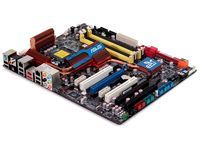
-
sparky2010 should've included 1920x resolutions in the last page, as there are a lot of people out there with screens capable of that resolution.. but anyways, all in all a very good and informative article.. but i'm going to settle with a complete makeover when core i7 becomes more available!Reply -
V3NOM yer kinda interesting to see how things have changed with new mobos but it doesnt really have any practical value tbh.Reply -
Crashman V3NOMyer kinda interesting to see how things have changed with new mobos but it doesnt really have any practical value tbh.Reply
It's all about answering the question "Will a second card do the job".
Lots of guys have midrange or better ATI graphics cards, and the question of "upgrade or replace" is constantly being asked. -
outlw6669 @ arkadiReply
Yes the x58 is out.
However, as it can not be paired with a Core 2 CPU and runs DDR3 exclusively, you can not directly compare the results.
In general, I would assume crossfire on the x58 will scale similarly to the x38/48 as they both have the same PCIe configuration. -
Crashman outlw6669Thanks for finally getting this review out!Reply
It was planned for September but kept getting delayed due to tight deadlines on other articles. But when the economy finally went from a slow decline to a nosedive in November, we knew this article had to come out right away. More people are putting new systems on hold and looking for ways to keep their old ones up to current performance standards, and we care about upgraders just as much as system builders.
Most Popular

